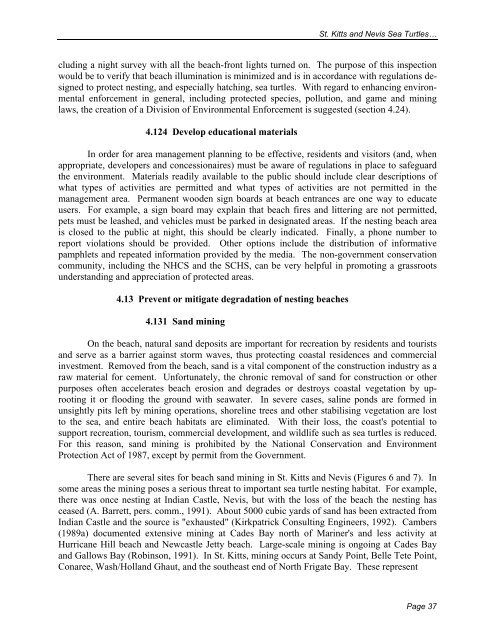Sea Turtle Recovery Action Plan for St. Kitts and Nevis - WIDECAST
Sea Turtle Recovery Action Plan for St. Kitts and Nevis - WIDECAST
Sea Turtle Recovery Action Plan for St. Kitts and Nevis - WIDECAST
You also want an ePaper? Increase the reach of your titles
YUMPU automatically turns print PDFs into web optimized ePapers that Google loves.
<strong>St</strong>. <strong>Kitts</strong> <strong>and</strong> <strong>Nevis</strong> <strong>Sea</strong> <strong>Turtle</strong>s…<br />
cluding a night survey with all the beach-front lights turned on. The purpose of this inspection<br />
would be to verify that beach illumination is minimized <strong>and</strong> is in accordance with regulations designed<br />
to protect nesting, <strong>and</strong> especially hatching, sea turtles. With regard to enhancing environmental<br />
en<strong>for</strong>cement in general, including protected species, pollution, <strong>and</strong> game <strong>and</strong> mining<br />
laws, the creation of a Division of Environmental En<strong>for</strong>cement is suggested (section 4.24).<br />
4.124 Develop educational materials<br />
In order <strong>for</strong> area management planning to be effective, residents <strong>and</strong> visitors (<strong>and</strong>, when<br />
appropriate, developers <strong>and</strong> concessionaires) must be aware of regulations in place to safeguard<br />
the environment. Materials readily available to the public should include clear descriptions of<br />
what types of activities are permitted <strong>and</strong> what types of activities are not permitted in the<br />
management area. Permanent wooden sign boards at beach entrances are one way to educate<br />
users. For example, a sign board may explain that beach fires <strong>and</strong> littering are not permitted,<br />
pets must be leashed, <strong>and</strong> vehicles must be parked in designated areas. If the nesting beach area<br />
is closed to the public at night, this should be clearly indicated. Finally, a phone number to<br />
report violations should be provided. Other options include the distribution of in<strong>for</strong>mative<br />
pamphlets <strong>and</strong> repeated in<strong>for</strong>mation provided by the media. The non-government conservation<br />
community, including the NHCS <strong>and</strong> the SCHS, can be very helpful in promoting a grassroots<br />
underst<strong>and</strong>ing <strong>and</strong> appreciation of protected areas.<br />
4.13 Prevent or mitigate degradation of nesting beaches<br />
4.131 S<strong>and</strong> mining<br />
On the beach, natural s<strong>and</strong> deposits are important <strong>for</strong> recreation by residents <strong>and</strong> tourists<br />
<strong>and</strong> serve as a barrier against storm waves, thus protecting coastal residences <strong>and</strong> commercial<br />
investment. Removed from the beach, s<strong>and</strong> is a vital component of the construction industry as a<br />
raw material <strong>for</strong> cement. Un<strong>for</strong>tunately, the chronic removal of s<strong>and</strong> <strong>for</strong> construction or other<br />
purposes often accelerates beach erosion <strong>and</strong> degrades or destroys coastal vegetation by uprooting<br />
it or flooding the ground with seawater. In severe cases, saline ponds are <strong>for</strong>med in<br />
unsightly pits left by mining operations, shoreline trees <strong>and</strong> other stabilising vegetation are lost<br />
to the sea, <strong>and</strong> entire beach habitats are eliminated. With their loss, the coast's potential to<br />
support recreation, tourism, commercial development, <strong>and</strong> wildlife such as sea turtles is reduced.<br />
For this reason, s<strong>and</strong> mining is prohibited by the National Conservation <strong>and</strong> Environment<br />
Protection Act of 1987, except by permit from the Government.<br />
There are several sites <strong>for</strong> beach s<strong>and</strong> mining in <strong>St</strong>. <strong>Kitts</strong> <strong>and</strong> <strong>Nevis</strong> (Figures 6 <strong>and</strong> 7). In<br />
some areas the mining poses a serious threat to important sea turtle nesting habitat. For example,<br />
there was once nesting at Indian Castle, <strong>Nevis</strong>, but with the loss of the beach the nesting has<br />
ceased (A. Barrett, pers. comm., 1991). About 5000 cubic yards of s<strong>and</strong> has been extracted from<br />
Indian Castle <strong>and</strong> the source is "exhausted" (Kirkpatrick Consulting Engineers, 1992). Cambers<br />
(1989a) documented extensive mining at Cades Bay north of Mariner's <strong>and</strong> less activity at<br />
Hurricane Hill beach <strong>and</strong> Newcastle Jetty beach. Large-scale mining is ongoing at Cades Bay<br />
<strong>and</strong> Gallows Bay (Robinson, 1991). In <strong>St</strong>. <strong>Kitts</strong>, mining occurs at S<strong>and</strong>y Point, Belle Tete Point,<br />
Conaree, Wash/Holl<strong>and</strong> Ghaut, <strong>and</strong> the southeast end of North Frigate Bay. These represent<br />
Page 37
















